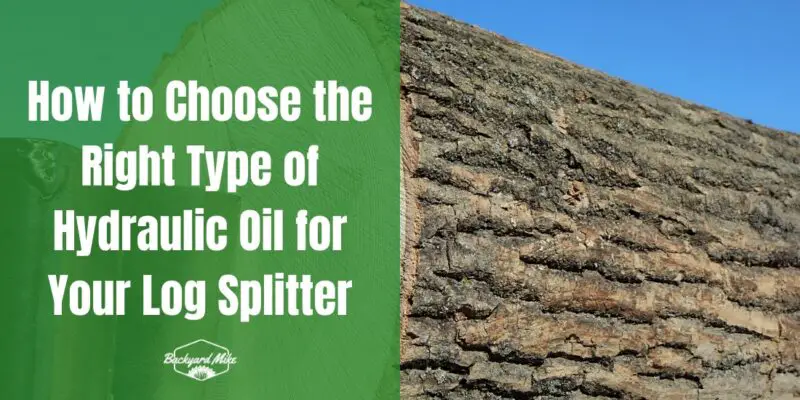To choose the right hydraulic oil for your log splitter, consider viscosity, climate, and compatibility. For cold weather, opt for low-viscosity oils like AW-32; in warmer climates, use higher viscosity like AW-46. Check the user manual for manufacturer recommendations on fluid type. Confirm the oil matches your system's materials to prevent corrosion. Regularly monitor and maintain oil levels for peak performance. Follow these steps for a well-functioning log splitter, guaranteeing you understand all aspects of hydraulic oil selection.
Key Takeaways
- Choose viscosity based on climate: AW-32 for cold, AW-46 for hot temperatures.
- Consult manufacturer recommendations for oil type and viscosity requirements.
- Consider synthetic oils for superior thermal stability and heavy-duty use.
- Ensure oil compatibility with pump designs to prevent corrosion.
- Regularly check and maintain oil levels to avoid operational issues.
Understanding Hydraulic Oil and Its Function in Log Splitters
Understanding hydraulic oil and its function in log splitters is essential for anyone using or maintaining this equipment.
Hydraulic oil basics involve its important role in transferring power from the engine or motor to the ram mechanism, a key aspect of log splitter mechanics. This oil operates under pressure within hydraulic cylinders, exerting force to split logs efficiently. Additionally, hydraulic oil must be non-compressible to ensure that no power is absorbed during the transfer process, maximizing the efficiency of the log splitter.
Transferring power efficiently, hydraulic oil is crucial in operating the ram mechanism of log splitters.
It also serves as a lubricant, ensuring smooth operation of moving parts. Viscosity greatly impacts the splitting process, with thinner oils offering faster flow and thicker oils providing more force.
In addition, maintaining thermal stability is crucial to keep the oil performing well in various temperatures. Proper understanding and use of hydraulic oil enhance performance, efficiency, and safety, extending the longevity of your log splitter.
Key Properties of Hydraulic Oil to Consider
When choosing hydraulic oil for your log splitter, focusing on key properties secures peak performance and longevity.
Start by considering hydraulic fluid characteristics such as viscosity, which guarantees efficient flow and system performance. Thermal stability is essential for maintaining oil performance factors across temperature changes, preventing degradation. Lubrication reduces friction, extending your equipment's lifespan, while corrosion protection shields metal components from harmful reactions.
Look for oils with air release and filterability features to avoid air pockets and maintain cleanliness. Manufacturer recommendations often found in user manuals can guide you in selecting the appropriate oil type for your log splitter.
Additives also play a role. Anti-wear additives protect moving parts, oxidation inhibitors prevent oil breakdown, and demulsification agents help separate water from oil. Foaming inhibitors reduce foam formation, and viscosity index improvers guarantee adaptability to temperature fluctuations.
Prioritizing these factors fosters a sense of belonging among like-minded users.
Choosing the Right Viscosity for Your Climate
After understanding the key properties of hydraulic oil, it's time to focus on selecting the right viscosity for your climate to guarantee your log splitter performs at its peak.
Consider viscosity effects and temperature considerations to find the ideal match. In cold climates, choose lower viscosity oils like AW-32 or ISO-32, which flow easily and secure smooth startups. An important aspect to keep in mind is that viscosity decreases as temperature increases, affecting the flow characteristics of the oil.
Opt for AW-32 or ISO-32 in cold climates for smooth startups and easy flow.
For hot weather, opt for higher viscosity options such as AW-46 or ISO-46 to maintain effective lubrication. If your climate varies, multigrade oils offer flexibility but may compromise air separation.
Always align your choice with the region's prevailing temperatures and equipment demands. Following manufacturer recommendations assures peak performance and extends your log splitter's lifespan, helping you belong to the informed community of hydraulic oil users.
Types of Hydraulic Oils and Their Applications
Hydraulic oils come in various types, each suited for specific applications and conditions. Mineral oils, derived from crude oil, are cost-effective and perfect for general industrial use. They offer good lubrication and anti-wear properties but lack the thermal stability of synthetic options. Synthetic oils, on the other hand, are chemically engineered for enhanced performance, providing superior thermal stability and longevity, making them ideal for heavy-duty equipment in critical systems. While more expensive, they often include biodegradable components. Multi-grade hydraulic oil maintains viscosity under extreme conditions, making it an excellent choice for applications with fluctuating temperatures. If you're considering environmental impact, bio-based oils, made from renewable resources, are biodegradable but may underperform compared to mineral and synthetic oils.
Assessing System Compatibility and Manufacturer Recommendations
To guarantee your log splitter operates efficiently, start by matching the hydraulic oil specifications with the manufacturer's recommendations. Always consult the user manual for the recommended fluid type and viscosity requirements, as these are essential for maintaining peak performance. Regularly checking your fluid levels can prevent operational issues and ensure your log splitter remains in optimal condition.
Matching Oil Specifications
- ISO Viscosity Grades: Choose the right ISO grade, like 32, 46, or 68, to match the operating conditions of your log splitter. Consider using AW32 for lower temperatures or AW46 for higher temperature applications, as the viscosity will affect the performance based on environmental conditions.
- Fluid Type: Opt for mineral, synthetic, or water-based oils based on thermal stability and operating environment.
- Component Compatibility: Guarantee the oil is compatible with pump designs and materials, preventing corrosion and wear.
Consult Manufacturer Guidelines
Although it might seem straightforward, consulting the manufacturer's guidelines is essential for guaranteeing your log splitter operates efficiently. Begin by reviewing the oil specifications outlined in your manual. These guidelines consider compatibility factors such as the design of your pump and hydraulic system, recommended viscosity grades, and fluid volume requirements. Pay attention to the oil type specifications, whether mineral or synthetic, to avoid damaging your equipment. Also, consider environmental conditions and system pressure, as these influence the right oil choice. It's important to note that transmission fluids like Dexron and Mercon are suitable alternatives, offering better performance across various temperatures. Following the manufacturer's recommendations for regular maintenance, including oil changes and monitoring, can enhance performance and longevity.
Maintenance Tips for Optimal Hydraulic Oil Performance
When maintaining your log splitter, you must prioritize regular oil changes and system checks to guarantee peak hydraulic oil performance.
Fluid maintenance is essential, so monitor oil levels before each use. Low fluid levels can drastically reduce performance. Aim for oil changes every 50 to 150 hours, depending on quality and usage, following manufacturer guidelines. It's crucial to ensure trapped air is expelled from the system for optimal operation, as air can affect hydraulic efficiency.
Keep an eye on the oil's clarity; milky or cloudy oil signals moisture and needs immediate changing.
- System Inspection: Regularly check for leaks using cardboard or wood under suspected areas. Replace worn seals to maintain pressure.
- Cleaning and Storage: Clean the splitter to remove debris, and store it in a dry place with a waterproof tarp.
- Air Bleeding: After adding fluid, bleed air from the cylinder by extending the piston rod fully.
Enhancing Log Splitter Efficiency With the Right Oil Selection
Selecting the right hydraulic oil for your log splitter is essential for enhancing its efficiency and longevity. You want to prevent oil degradation, which can hinder performance.
Begin by considering operational conditions, as oil viscosity affects performance optimization. Lower viscosity oils like ISO-32 work well in colder climates, while ISO-46 suits warmer temperatures. Selecting the correct viscosity grade is crucial because it must match the operating temperature range of the hydraulic system to ensure maximum efficiency and to avoid faster degradation of components.
Opt for anti-wear (AW) oils if protection is a priority, as they reduce system wear and extend equipment life. Follow OEM recommendations for viscosity and oil type to guarantee compatibility and maintain warranties.
High-quality oils, like synthetic blends, offer better thermal stability and durability. Although they might seem costly, they improve performance and extend operating hours, making them a smart investment for your log splitter's efficiency.
Frequently Asked Questions
What Is the Difference Between AW and ISO Grade Hydraulic Oils?
You'll find AW properties focus on anti-wear additives for protection, while ISO viscosity emphasizes fluid thickness. Both guarantee system efficiency, but AW enhances longevity. Choose based on your machinery's needs, guaranteeing you're part of its ideal performance.
Can I Mix Different Brands of Hydraulic Oil in My Log Splitter?
Imagine your log splitter's heart beating with precision. You can mix brands, but guarantee viscosity and additives match. Brand compatibility ensures seamless oil performance, like a harmonious melody, keeping your splitter strong and part of the family.
How Does Hydraulic Oil Affect the Speed of My Log Splitter?
Your log splitter's speed hinges on hydraulic oil's viscosity and performance. Thicker oils slow it down in cold conditions, while thinner ones enhance speed. Choosing the right viscosity guarantees efficient operation, making you part of the informed community.
Is It Safe to Use Recycled Hydraulic Oil in Log Splitters?
Imagine a secondhand suit—it might fit, but lacks the tailored precision of new. Using recycled oil in your log splitter might save costs but risks compromising hydraulic oil quality and performance. Stick to manufacturer recommendations for best results.
How Do I Dispose of Used Hydraulic Oil Properly?
You've got to handle used oil responsibly. Explore disposal methods like recycling or using licensed carriers for transportation. By doing so, you'll protect the environment and join a community committed to sustainability and compliance.
Conclusion
To choose the right hydraulic oil for your log splitter, consider the oil's viscosity, your climate, and your splitter's specific requirements. Always refer to manufacturer recommendations to guarantee compatibility, as the wrong oil can drastically reduce efficiency and damage your equipment. Regular maintenance, including timely oil changes, is essential for peak performance. With the right oil, your log splitter will operate smoothly, making your wood-splitting tasks feel like a breeze, promoting longevity and optimal performance.


